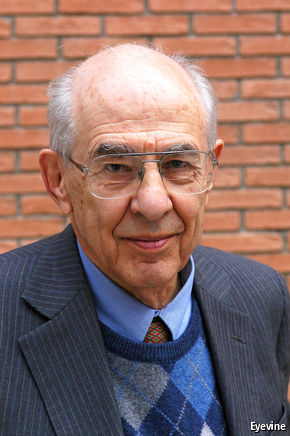Obituary: Hilary Putnam
The meaning of meaning
Hilary Putnam, a philosopher, died on March 13th, aged 89

TO BE identified with a distinctive position is an academic career’s crowning achievement. Hilary Putnam did better than that: his intellectual odyssey meant that on some of the most important controversies in modern philosophy he had defined and defended positions on both sides of the argument.
His Socratic self-questioning was notable, but his hallmark was thought experiments. He posited iron-willed, poker-faced Spartans to show that pain was not just about expression. To prove that meaning in language was not solely about what is intended, he proposed identical twins living on identical planets, which differed only in that water on one of them was not H2O but another substance with similar properties. Each twin would refer to “water”, intending the same meaning—but they would be referring to different things.
By modern, hyper-specialised academic standards Mr Putnam ranged widely. His work included logic, ethics, metaphysics, political thought, mathematics, and the philosophy of science, of mind, of economics, of literature, of language and of religion. His early stance was that if humans can be said to have mental states, then it is impossible to say that machines do not. This was the basis of what became known as functionalism—the idea that what matters about mental states is what they do, not what they are made of.
Over time he became less keen on thinking of the mind only in terms of what happens inside the brain. Instead he adopted externalism: “meanings just ain’t in the head”. Refining Wittgenstein, he posited a linguistic division of labour, analogous to Adam Smith’s thinking in economics. The people best able to determine a word’s meaning do so on the basis of expertise. Others then rely on their usage. As a Harvard philosopher, he might have no idea how to tell an elm from a beech, but he could confidently use the words with the assurance that botanists knew exactly what they meant.
A related example of the tension between knowledge and reality came with another thought experiment: a sceptic might wonder whether she were no more than a brain in a vat, artificially nourished, and stimulated with a bogus but utterly convincing version of the real world. How could one prove that this is not so? The answer is that our brains are more than just perception machines, and meaning depends on what other people think too. So a brain in a vat might exist, but it could not meaningfully say that it was merely a brain in a vat. Philosophers would call that epistemological externalism: factors outside the mind are crucial to what it can be said to “know” and “think”.
Many saw parallels between that controversy and “The Matrix”, a successful Hollywood film which bridged science fiction and philosophy. It portrayed a dystopia in which machines have subdued humans by trapping them in a simulated reality while their bodies languish in vats.
Mr Putnam was surprised and flattered by the film-makers’ interest. He was not a populariser, liking the quip: “any philosophy that can be put in a nutshell belongs in one.” But he wanted philosophy to relate to the real world. It should fit the complexity of human existence and civilisation, and not the other way round.
Reloaded
That was a reaction to the arid logical positivism he was taught as a student—the idea, once dominant in the English-speaking academic world, that philosophy is really a branch of science and that the only knowledge that matters is what can be empirically verified. One of his famous courses at Harvard was a direct challenge to the logical positivist approach: it featured “non-scientific knowledge”, exploring the philosophy of aesthetics and ethics.
In his case involvement in the real world mostly took the form of left-wing politics, where his views were almost as versatile as his philosophy. Born to communist parents (his father was a columnist for the Daily Worker), he lived in a commune, campaigning against the Vietnam war and joining the Progressive Labour Party, an exotic outfit for those who found the Communist Party too staid. He would stand outside factory gates in the early morning, trying to sell magazines and to discuss politics with the workers. He baffled his students by sitting among them during lectures, though later he took to the podium to brandish Mao’s “Little Red Book”. Harvard tolerated him more than he tolerated disagreement: he disrupted a colleague’s lectures because researching inherited intelligence was racist.
He later recanted his communism, and also his fervent secularism (he once dismissed an Oxford philosopher’s argument that no machine could be an adequate representation of the mind with the scornful put-down: “If I believed that, I would have to be not only a Theist but an Episcopalian”). Yet the final great enthusiasm of his life was Judaism. He and his wife Ruth Anna were determined to recover the identity that his parents’ generation had rejected, and they created a Jewish household for their children. Mr Putnam himself had his own bar mitzvah in 1994, aged 68. He learned Hebrew, and wrote a book on Jewish philosophy as a guide to life: seeking proof, he argued, missed the point of religion. It was what it did that mattered.

No comments:
Post a Comment